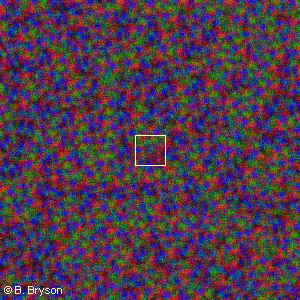Scale: 10-15 meters = 1 fm = 1 femtometer
A ProtonThis pattern of colored dots is an abstract representation of the 'surface' of a proton -- a kind of boundary layer of the three strongly interacting quarks. All particles that are built of quarks belong to one of two families. Mesons consist of a single quark and a single antiquark; baryons consist of three quarks. Protons and neutrons are the lowest energy examples of baryons. Baryons and mesons are collectively known as hadrons. There are over 200 known hadrons. Recognition of the patterns within this array of hadrons allowed physicists in the 1960s and '70s to develop the Standard Model of high energy physics. The proton is made up of two up quarks and one down quark. Up quarks have a charge of +2/3 and spin 1/2, while down quarks have a charge of -1/3 and spin -1/2. These three quarks combine as a result of the strong nuclear force to result in a proton of charge +1 and spin +1/2. Similarly, a neutron consists of one up quark and two down quarks, with charge 0 and spin 1/2. Copyright © 2016 by Bruce Bryson |
